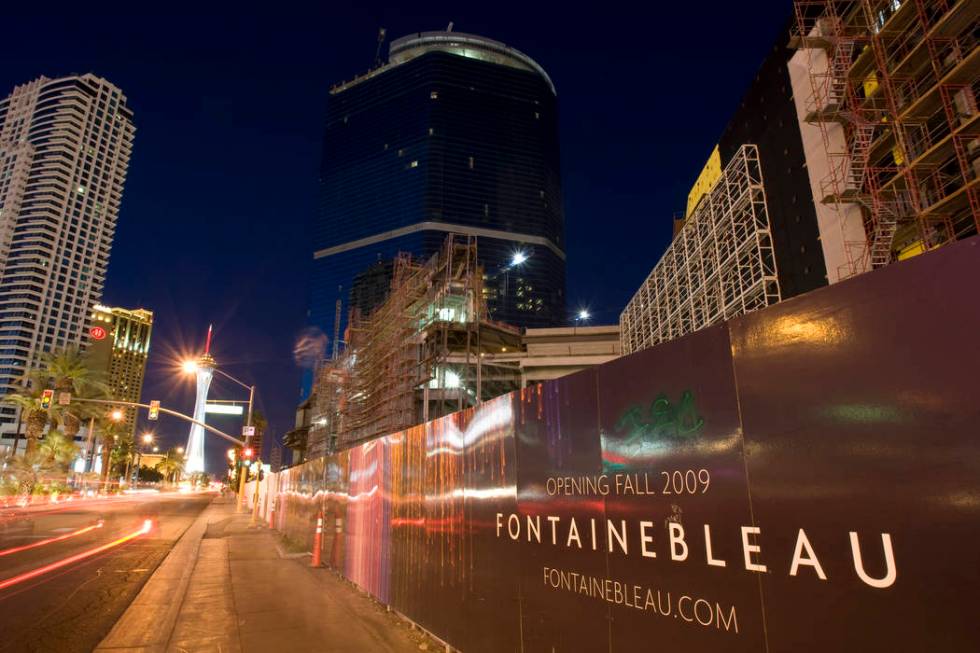10 years since Fontainebleau in Las Vegas went bankrupt

With the economy crashing in spring 2009, developers of the Fontainebleau gave their lenders a dire warning: Without more funds, the project will fail.
Less than two months later, the partially built hotel-casino was in bankruptcy. A decade later, the blue-tinted tower on the north Strip is still waiting to be finished.
The Fontainebleau, soaring 60-plus stories above Las Vegas Boulevard, went bankrupt 10 years ago on June 9, 2009. It has traded hands twice since then, with current owner Steve Witkoff planning to open the 3,780-room resort, which he renamed The Drew Las Vegas, in 2022.
Las Vegas was littered with abandoned real estate projects after the economy tanked, but most were eventually finished, typically after investors bought them at a steep discount. The Fontainebleau, one of the tallest buildings in the valley, also sold for a relative pittance during the recession. But the buyer, billionaire Carl Icahn, barely touched it as the tower became a constant reminder of Las Vegas’ wild real estate boom and devastating crash.
Given the bankruptcy anniversary on Sunday, here’s a look at the Fontainebleau’s history — one marked by big money, big promises and a big flop.
‘Most celebrated building’
Plans for the Fontainebleau were unveiled in 2005. The project — led by Florida developer Jeff Soffer of Turnberry Associates and Las Vegas casino executive Glenn Schaeffer, former president of Mandalay Resort Group — was named after the 1950s-era Fontainebleau hotel in Miami Beach, which Soffer agreed to buy months earlier.
Fueled by easy money, Las Vegas property values soared during the mid-2000s bubble, and developers flooded the valley with housing tracts, office buildings, high-rise condo proposals and megaresort projects.
“With what is happening in Las Vegas, you look (at) that site and we can do a tremendous project,” Soffer said after the plans were announced.
His group broke ground in early 2007. Later that year, the developers said they closed on financing that would be used, in part, to fully fund the $2.9 billion Strip resort.
The Fontainebleau was slated to open in fall 2009.
“It is destined to become the most celebrated building in the world,” Schaeffer said.
‘Will never open’
The economy was already showing signs of cracks by that point. It eventually imploded, with Las Vegas among the hardest-hit areas of the country during the recession.
As the economy spiraled, the Fontainebleau’s developers sued several banks in April 2009, alleging that the “unscrupulous” lenders backed out of their commitment to finance construction of the resort. The banks cited one or more alleged defaults, but the developers claimed there weren’t any, the lawsuit said.
The Fontainebleau was about 70 percent complete, though without the additional funds, the resort “cannot be finished and will never open,” the developers alleged.
Soon enough, construction work slowed at the site, Schaeffer left as president and CEO of parent company Fontainebleau Resorts, and the developers pushed the Las Vegas project into bankruptcy.
Icahn bought the mothballed tower in 2010 for around $150 million. He sold it in 2017 for $600 million to Witkoff, founder of New York development firm the Witkoff Group, and partners.
Soffer, now owner of Fontainebleau Development, and Schaeffer could not be reached for comment.
In an interview at the Drew in April, Witkoff told me he heard “150 nasty rumors” about the building before he bought it, including that it was falling down, that copper cables were stolen and that plumbers poured concrete in the pipes.
In truth, he said, the building is in “exceptional shape.” He also praised Soffer as an “outstanding developer” whose project got derailed by the failing economy.
“He did it impeccably,” Witkoff said of the resort. “The only mistake he made was he ran into the worst financial storm in U.S. history but for the Depression, which is unfortunate.”
Contact Eli Segall at esegall@reviewjournal.com or 702-383-0342. Follow @eli_segall on Twitter.